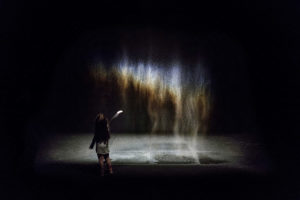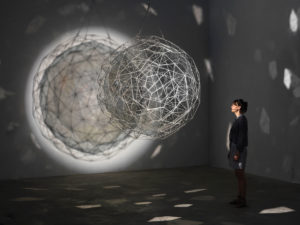The monographic exhibition Olafur Eliasson: In Real Life is a retrospective dedicated to the famous Danish artist (1967), and aims at consecrating his practice that has emerged in the 1990s at the intersection of art, science, and philosophy, by superseding the horizons of knowledge through the study of innovative structures, new geographies, and a ludic approach. Once again, the TATE pays homage to the artist after his famous intervention at the Turbine Hall in 2003, with The Weather Project, which has followed the Light Movement projects, 2012, Little Sun, 2012, and the artist’s tribute to English Romanticism with the work Tuner color experiments, in 2014, at TATE Britain. Suggesting here a reflection on more than twenty years of artistic practice, the exhibition In Real Life, gives us access to Eliasson’s practice which propose an enquiry on the role of experience as a field of knowledge, following the use of an experimental approach as we perceive in the cabinet of prototypes that constitutes the Model Room, 2003, wherein we familiarize with studies on matter, ecology, and the cosmos.
Through an exhibitive path, designed to create a free and personal experience of the exhibition, we are immersed in an atmosphere that suggests us a reflection on the dualism between nature and artifice in terms of artistic practice, technical experimentation, and at the limit of perceptive experience. Thus, in the room dedicated to the early stage of Eliasson’s research, we perceive the interest in rethinking the use of materials departing from a practical reflection, as seen in the work Window projection, 1990, and the installation Wavemachines, 1995, which reinvents the modules of minimalist sculpture with reference to the mechanical, physical, and electrodynamic laws of primary elements such as light and water. The great installation Moss Wall, 1994, proposes an image of nature that is autonomous from the domain of the pure reasoning of man by exploring the continuous metamorphosis of nature. Having identified the materials that characterized Eliasson’s practice, we perceive the sign of the artist in the installation I grew up in solitude and silence, 1991, which establishes a well articulated dialogue with the immersive installation Beauty, 1993, that offers us a way of rethinking nature and the atmosphere in the contemporary context.
As we walk through the field of the installation How do we live together? 2019, suggesting us a mode of dwelling the works on display, the exhibition In Real Life presents an atlas of photographic images that is taken from the artist’s less known works such as the series The glacier series, 1999, Melting ice in Gunnar’s land, 2008, The river-raft series, 2000, which interact with the circular palette of Color experiment no.81, 2019. Through a play of contrasts and forms, these photographic works interact with the immersive installation Your uncertain shadow (color), 2010, which embraces the viewer by simultaneously projecting the shadow and dynamism of the spectrum of lights. In this sense, Eliasson suggests a mode of thinking that is a thought in movement and in relation, as we can see for the installation A description of a reflection, 1995.
We are pleased to see inedited works such as In real life, 2019, and Your planetary window, 2019, where we encounter the playful game of forms, structure, and matter in contact with the concrete. This experience prepare us to traverse the installation Your spiral view, 2002, wherein, whilst remembering the estrangement that we initially felt in front of Eliasson’s innovative forms at the 50th Venice Biennale in 2003, we better retrace here the artistic that underlies Eliasson’s practice which aims at proposing an artificial image for the Plato’s Allegory of the Cave and its pedagogical purposes. This accent continues in the section The Expanded Studio, wherein we experiment with the models Green light, 2016, Little Sun, 2012, and The Structural evolution project, 2001, as part of an interactive, collective artistic experience.
In conclusion, we perceive a continuum between the artistic experience inside the museum and the real-life experience when, out of the spaces of the TATE Modern’s exhibition, we encounter a series of artworks designated for the public dimension such as Room for one color, 1997, Stardust particle, 2014 , Ventilator, 1997, Cold wind sphere, 2012, Waterfall, 2019. Until January 5, 2020, the exhibition Olafur Eliasson: In Real Life is completed by a series of debates, talks, and meetings which will discuss the influence of Eliasson’s artistic in the contemporary context.
Info:
Olafur Eliasson: In real life
11 July 2019 – 5 January 2020
www.tate.org.uk
 Olafur Eliasson, Moss wall, 1994 Reindeer moss, wood, wire Dimensions variable
Olafur Eliasson, Moss wall, 1994 Reindeer moss, wood, wire Dimensions variable
Installation view: Leeum, Samsung Museum of Art, Seoul, 2016 Photo: Hyunsoo Kim © 1994 Olafur Eliasson Courtesy of the artist; neugerriemschneider, Berlin; Tanya Bonakdar Gallery, New York / Los Angeles © 1994 Olafur Eliasson
 Olafur Eliasson, Beauty, 1993 Spotlight, water, nozzles, wood, hose, pump Dimensions variable Installation view at Moderna Museet, Stockholm, 2015 Photo: Anders Sune Berg Courtesy of the artist; neugerriemschneider, Berlin; Tanya Bonakdar Gallery, New York / Los Angeles © 1993 Olafur Eliasson
Olafur Eliasson, Beauty, 1993 Spotlight, water, nozzles, wood, hose, pump Dimensions variable Installation view at Moderna Museet, Stockholm, 2015 Photo: Anders Sune Berg Courtesy of the artist; neugerriemschneider, Berlin; Tanya Bonakdar Gallery, New York / Los Angeles © 1993 Olafur Eliasson
 Olafur Eliasson, Stardust particle, 2014 Stainless steel, translucent mirror-filter glass, wire, motor, spotlight Ø 1760 mm Tate Photo: Jens Ziehe, 2017 © 2014 Olafur Eliasson
Olafur Eliasson, Stardust particle, 2014 Stainless steel, translucent mirror-filter glass, wire, motor, spotlight Ø 1760 mm Tate Photo: Jens Ziehe, 2017 © 2014 Olafur Eliasson

She is interested in the visual, verbal and textual aspects of the Modern Contemporary Arts. From historical-artistic studies at the Cà Foscari University, Venice, she has specialized in teaching and curatorial practice at the IED, Rome, and Christie’s London. The field of her research activity focuses on the theme of Light from the 1950s to current times, ontologically considering artistic, phenomenological and visual innovation aspects.






NO COMMENT